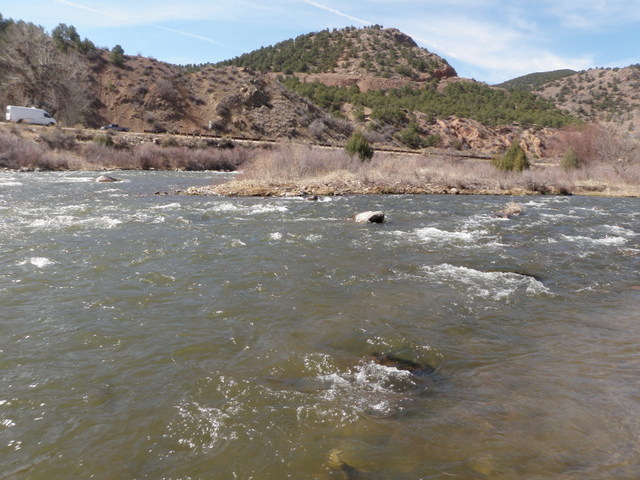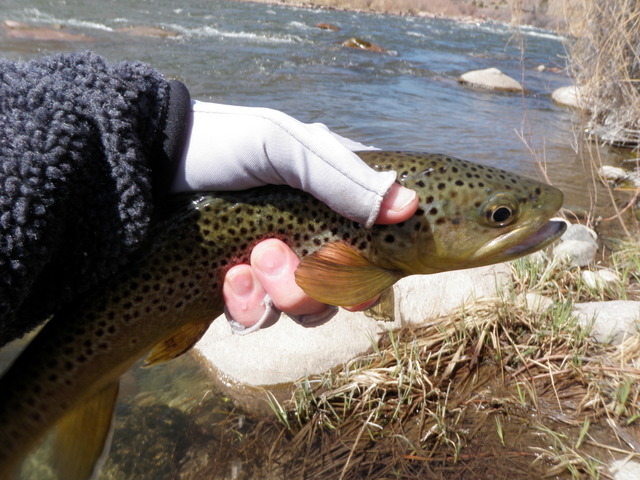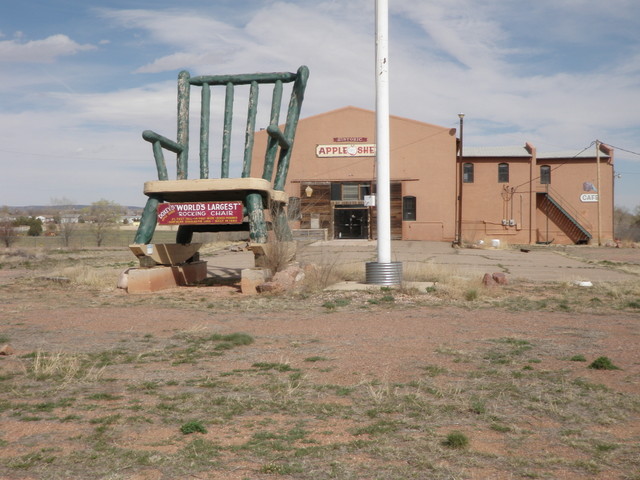Time: 10:30AM – 2:00PM
Location: Below Texas Creek
Fish Landed: 3
Arkansas River 04/09/2014 Photo Album
The story line for Wednesday is wind. I was anxious to go fishing after nearly a two week hiatus, and when I noticed the weather forecast for March 9 with a high temperature of 78 degrees, I exercised poor judgment and discounted the “windy” part of the report.
The fly shops near the Arkansas River were raving over the blue wing olive hatches, so I decided to make the trip. As it turns out, I spent more time driving than fishing with five hours necessary to make the long trip to lower Bighorn Sheep Canyon and back. I arrived at the parking lot at Texas Creek by 10AM, and after putting on my gear, rigging my rod, and hiking along the path to the area below the island it was nearly 10:30AM. I worked the sweet run below the island with a weighted 20 incher and a RS2, but these flies didn’t produce any fish in spite of some great drifts through very attractive water.
When I arrived at the head of the run, and the two fly combination continued to fail, I replaced the RS2 with a bright green go2 caddis. This generated more interest, and I landed a tiny brown trout that was less than six inches and then hooked another small fish that managed to free itself from the fly. Next I worked up along the right side of the island, and once again entered a slump until I arrived near the top of the right channel. Here I finally felt the tap of a fish and responded with a hook set that led to the throb of a live fish. The first fish of the day was a skinny brown trout of approximately 12 inches. I continued along the right bank and added another nine inch brown that pounced on the go2 caddis, and by noon my stomach was growling so I walked back to the car for lunch.
I grabbed my lunch bag and water bottle and climbed down the bank below the bridge and sat on the stone beach so I could observe the water while I ate. Sometimes this enables me to spot or observe fish, but on this day, I simply watched the water flow and the wind blow the willows. While I was eating lunch two gentlemen arrived in their pick up truck, and they were ready to fish before me, so they went through the gate and hiked down the path. I was relatively close behind, and I intended to begin fishing after lunch where I ended the morning. Unfortunately the two fishermen stopped at that exact spot, so I dropped down to the river a good distance above them and began working my way back toward the bridge.
The 20 incher was not producing any fish, so I moved the go2 green caddis to the top position and then knotted a BWO soft hackle emerger to my line as the point fly. For the next two hours I worked these flies upstream through the 15 feet of water next to the right bank. I continued under the bridge and another 300 yards beyond, and I added one eleven inch brown trout to my count. The fishing was extremely frustrating due to the constant wind, and my attempt to fish a two fly nymph set up. Because I am right handed, most of my casts required a backhand sling, and needless to say this resulted in numerous entanglements.
The flows were up somewhat for this time of the year and running around 674 cfs when I normally expect around 500 cfs. The water was slightly off color but not enough to impact the fish’s visibility. I discovered that quite a few fish were resting in the clear low water next to the bank, but they were very skittish. In order to cast the indicator, split shot and flies into the strong wind, I needed to accelerate my forward stroke and push my rod tip down toward the surface of the water. Unfortunately this style of casting resulted in quite a splash when the split shot and indicator splashed down in the relatively shallow water within five feet of the bank. I observed at least twenty fish scattering and hiding due to the disruption caused by my approach and casting method.
Unfortunately there really wasn’t an alternative. If I tried to fish from above, the fish would see me and scatter even more hastily. If the wind had been less of a factor, I would have tried a buoyant attractor with a nymph dropper to cover the shallow edge water, as these flies would have caused less disturbance. However, the wind was so strong that this approach would have resulted in the flies landing at my feet with each cast no matter how much I overpowered the forward stroke.
The wind, the tangles, and the constant fruitless casting finally took their toll on me, and I reeled up my line and returned to the car at 2PM. It was a difficult day on the Arkansas River, and I learned that air temperature is not the only factor to consider when choosing a day to fish in Colorado.



